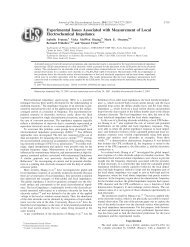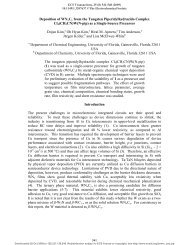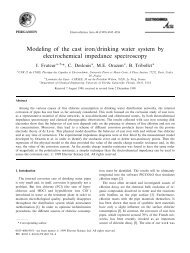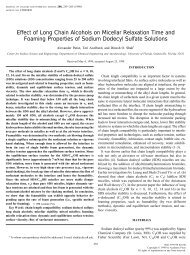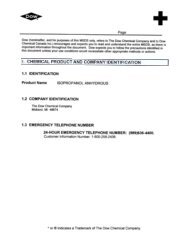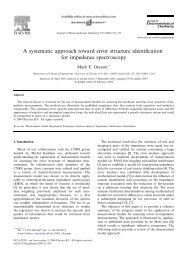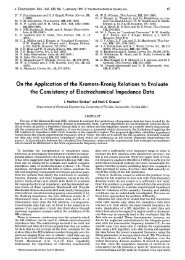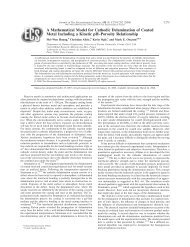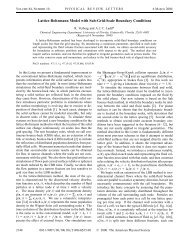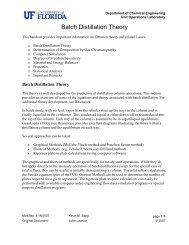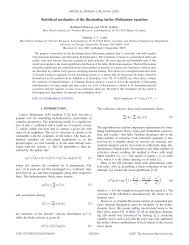Measurement Models for Electrochemical Impedance Spectroscopy ...
Measurement Models for Electrochemical Impedance Spectroscopy ...
Measurement Models for Electrochemical Impedance Spectroscopy ...
You also want an ePaper? Increase the reach of your titles
YUMPU automatically turns print PDFs into web optimized ePapers that Google loves.
J. Electrochem. Soc., Vol. 142, No. 12, December 1995 9 The <strong>Electrochemical</strong> Society, Inc. 41531000I| , , , , .0.2 .... ''I ....... '1 " ...... I '"'"1 ' ....... I '"'""500r---500-1000: o o:. oo, , , I , , , ,~NLNIIL.N0 . 0 ~-1000 -500 0 500 1 )00%, QFig. 6. The imaginary departures from the mean residual errorere, i -- ere, <strong>for</strong> the regression shown in Fig. 4 and 5 as a function ofthe' corresponding real values.errors associated with the lack of fit of the model. The timevaryingcharacter of the measurements is not readily apparentin Fig. 3, but examination of the residual errorsshows that the system changed from one experiment to theother and that the residuals <strong>for</strong> the six experiments can bedistinguished from one another.The measurement-model analysis shown in Fig. 4 and 5shows that the standard deviation obtained using Eq. 8must contain, in addition to the desired stochastic contributionto the error structure, a significant contributionfrom a nonstationary bias component. The standard deviationsthat are corrupted by such bias errors show severaldistinctive features. The real and imaginary departuresfrom the mean residual error are correlated, as shown inFig. 6. The standard deviations calculated using Eq. 8 areshown in Fig. 7 as a function of frequency. Examination ofreal and imaginary values suggests that they are not equal.Both observations are counter to results obtained <strong>for</strong> sta-b104 ......... ' ........ ' ........ ' ........ ' ....... ' .10 2- -2--;'--I 0 - 4 _ 'I ....... I ........ j ........ i ........ i ......10 10 0 10 1 10 2 10 `5 10 4 10 5Frequency, HzFig. 7. Unfiltered standard deviation of the data shown in Fig. 3 asa function of frequency. Circles represent the real, and the trianglesrepresent the imaginary part of the standard deviation. The solid linerepresents the error structure <strong>for</strong> the n-GaAs sample held at 320 K(see Eq. 14). The dashed line represents the contribution that is proportionalto I Z.i I, the dashed-dot line represents the contribution thatis proportional to I Zrl, and2the dashed-dot-dot-dot line is the cantributionproportional to IZI /R,. The discontinuity apparent in thesolid line and the dash-dot-dot-dot line is caused by a change of thevalue of the current measuring resistor at 100 Hz.-0.2 ........ I .... ,,,I ....... J , ,,,,,,,I , ,,,,,.I ......10 -1 100 101 102 103 104 105Frequency,Fig. 8. Real residual errors <strong>for</strong> the separate regression of measurementmodels to the data shown in Fig. 3.tionary data, where the real part of the standard deviationwas observed to be equal to the imaginary part.For nonstationary systems, the stochastic component ofthe error cannot be calculated by taking the standard deviationof the residual errors directly. A procedure to filterout the nonstationary component of the error is outlined inthe next section. The significance of the lines in Fig. 7 isdiscussed in later sections.Identification of the noise modeL--For nonstationarydata, a measurement model is regressed to each data setusing the maximum number of parameters that can be resolvedfrom the data. For this work, a complex nonlinearleast squares program was used that was developed inhouse?'8 As a model <strong>for</strong> the stochastic contribution to theerror structure is not known a priori, modulus weighting istypically used <strong>for</strong> the regression. The regressed parameters<strong>for</strong> the measurement model <strong>for</strong> each data set are slightlydifferent because the system changes from one experimentto the other. Hence, by regressing the measurement modelto individual data sets separately, the effects of the changeof the experimental conditions from one experiment to anotherare incorporated into the measurement modelparameters. The standard deviations of the real and imaginaryresidual errors there<strong>for</strong>e can be obtained as a functionof frequency and provide a good estimate <strong>for</strong> the standarddeviation of the stochastic noise in the measurement.The data set from Fig. 3 is used to illustrate the technique.The normalized real and imaginary residual errors<strong>for</strong> six regressions are shown in Fig. 8 and 9. The real andimaginary residual errors are randomly distributed aboutthe mean value at a given frequency. The plot of the imaginaryvs. real departures from the mean residual error,shown in Fig. 10, further suggests that the residual errors ata given frequency are not correlated. The cyclic behavior ofthe residual errors with frequency is caused by the lack offit of the model. The technique of estimating the standarddeviation of the stochastic contribution by calculating thestandard deviation of the residual errors is in effect a filter<strong>for</strong> lack of fit. Using the measured error structure to weightthe regression of data that are free of bias errors, theresidual errors <strong>for</strong> the measurement model can be made tobe of the same order as the standard deviation of themeasurement. 9The real and imaginary standard deviations of the residualerrors are shown as a function of frequency in Fig. 11.Hz



